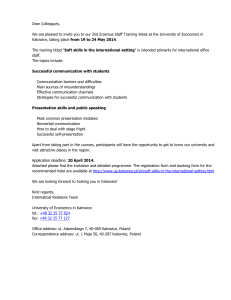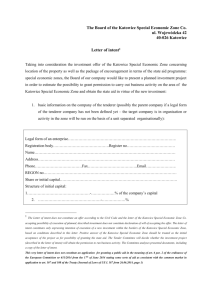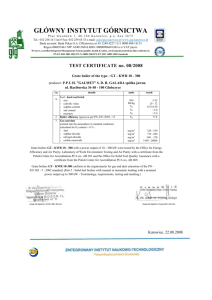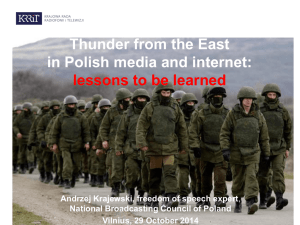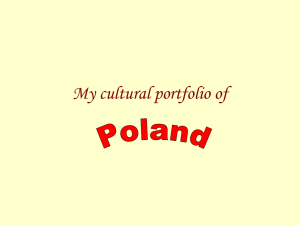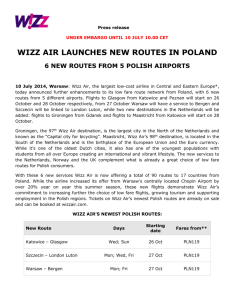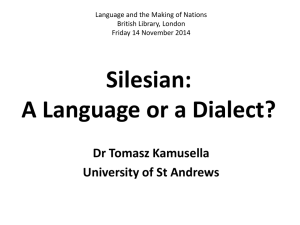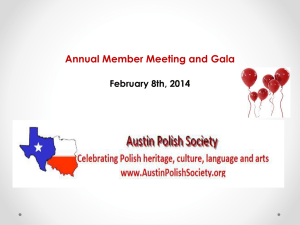Poland
advertisement
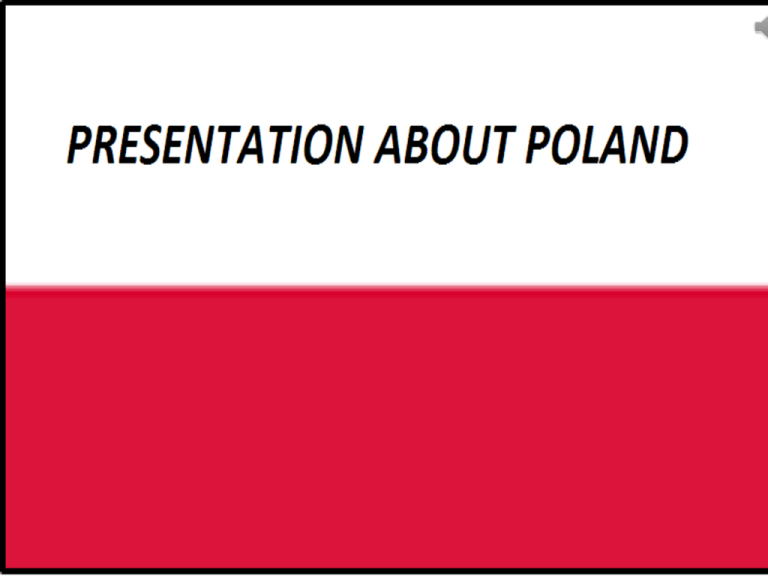
The Republic of Poland is a country in Central Europe bordered by Germany to the west, the Czech Republic and Slovakia to the south, Ukraine and Belarus to the east, and the Baltic Sea, Kaliningrad Oblast and Lithuania to the north. Polad is slavic country, official language is Polish and it has 38 530 000 residents. Poland’s flag and coat of arms The flag of Poland consists of two horizontal stripes, the upper one white and the lower one red. White and red are officially colors of the Poland. The national flag was officially adopted in 1919. Since 2004. Polish Flag Day is celebrated on May 2. The White Eagle is the national coat of arms of Poland. It is a white eagle wearing a golden crown, in a red shield. The White Eagle emblem originated when Poland's legendary founder Lech saw a white eagle's nest. When he looked at the bird, a ray of sunshine from the red setting sun fell on its wings, so they appeared tipped with gold, the rest of the eagle was pure white. He was delighted and decided to settle there and placed the eagle on his emblem. History • The name of Poland, which appears in the 11th century, comes from the ancient Slavic tribes who settled in the lowlands between the Oder and Vistula, after the fall of the Roman Empire in the 5th century. After the First World War, Poland was established as an independent state. After World War II, gained new territories in the West, but lost twice as large areas in the east. In 1999. Poland entered into an alliance NATO, and on 1 May 2004, joined the European Union. About Poland • Poland is mainly a lowland country. The largest part of the state occupies the Baltic lowland. The Baltic coast is low and marshy. The important economic sector is agriculture. Most are grown potatoes, sugar beet and cereals. More important industrial centers of the capital city od Warsaw, Krakow, Katowice, Poznan and Lodz. The capital is Warsaw, it’s situated in the center of the state. This is Warsaw’s old town. SILESIA -Silesia is historical area in the eastern part of Central Europe in the basin of the upper and middle Oder. -Mainly belongs to Poland and smaller parts are in Germany and Czech Republic. -It covers about 45,500 square kilometers. ETIMOLOGY OF THE NAME -The name is probably called after the Vandal ethnic group shillings or Slezan(Slezanie),who lived in the area before the arrival of the Slavs in the 5. century to the 9. century. The name of Silesia in the different language most likely share their etimology-Latin and English:Silesia,Polish:Slask,Old Polish:Slazsk(o),Silesian:Slunsk,German:Schlesien,Si lesian German:Sclasing,Czech:Slezsko,Slovak:Sliezsko,Kash ubian:Slask,Upper Sorbian:Šleska,Lower Sorbian:Šlazynska. NATURAL RESOURCES Silesia is the one of the biggest and richest coal basin in Europe. -On the basis of coal and metal ores(iron,copper,zinc,lead,cadmium)has developed a strong industry(metallurgy,machine building,textile industry and others). IN THE HISTORY SILESIA WAS ATTACKED BY… -Silesia has over the years been attacked and conquered by of the Great Principality,Czech Republic,AustriaHungary,Germany,Austria,Czechoslo vakia after World War II mostly went to Poland. SILESIA THROUGH THE YEARS The Silesian Piasts were the elder of four lines of the Polish Piast dynasty beginning with Władysław II the Exile (1105–1159), oldest son of Duke Bolesław III of Poland. By Bolesław's testament, Władysław was granted Silesia as his hereditary province and also the Lesser Polish Seniorate Province at Kraków according to the principle of agnatic seniority . SILESIAN PIESTS BIG CITIES IN SILESIA -Big cities in Silesia are Wroclaw,Ostrava,Katowice,Gliwice,Zabrze... GEOGRAPHY OF KATOWICE • Katowice is a city in upper Silesia in southern Poland on Kłodnica and Rawa rivers. Katowice is in the Silesian highlands north of Silesian Beskids. HISTORY OF KATOWICE • The first mention of Katowice dates from sixteenth century. When Katowice was a small village. • After discovery of coal and steel in the nearby hills the city has developed • Katowice became a part of Second Polish Republic after referendum in 1921. • In 1939 Katowice was annexed to Nazi Germany. During German ocupation, Germans killed many people and they destroyed the city monuments. The City was liberated by Red Army in January 1945. • Katowice was renamed Stalinogród in 1953 by Polish communist goverment, but the name Katowice was restored in 1956 because the city population never accepted name Stalinogród. PHOTOS OF KATOWICE IN THE PAST INHABITANTS OF KATOWICE • In Katowice there live 307,233 people, but the metropolitan area has between 3 and 3.5 million people. • Famouse people from Katowice are: Henryk Górecki famous Polish composer who composed Symphony No. 3., Kazmerz Kutz famous Polish film director and politician, Waldemar Świerzy Polish artist, Wojciech Kilar was Polish classical and film music composer, Jerzy Kukuczka was a Polish alpine and high-altitude climber. • Henryk Górecki AN INTERESTING BOND • One of the attractions of Katowice is the statue of Marshal Jozef Pilsudski , on horseback,who was the restorer of the Polish state.The statue was made by famous Croatian sculptor, Anton Augustinčić. ECONOMY OF KATOWICE • Katowice is the center of science, culture,industry, business, trade fair exhibitions and transport in upper Silesian region. • Today Katowice is rapidly growing city and emerging metropolis • It is also the 16th most economical powerful city by GDP in European Union. • Katowice is a large coal and steel center. It has several coal mines organized into unions, two steelworks and one foundry of non-ferrous metals KATOWICE TODAY
